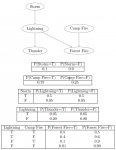I'm not sure how to start this problem. Can anyone describe what the steps to solving a problem like this are? Not looking for answers to the problem, but rather a method to solve these problems.

a) What is the probability of a forest fire?
b) What is the probability that there is a storm given that there is a forest fi re?
c) What is the probability of a camp fi re and a forest fire?
Thanks

a) What is the probability of a forest fire?
b) What is the probability that there is a storm given that there is a forest fi re?
c) What is the probability of a camp fi re and a forest fire?
Thanks
